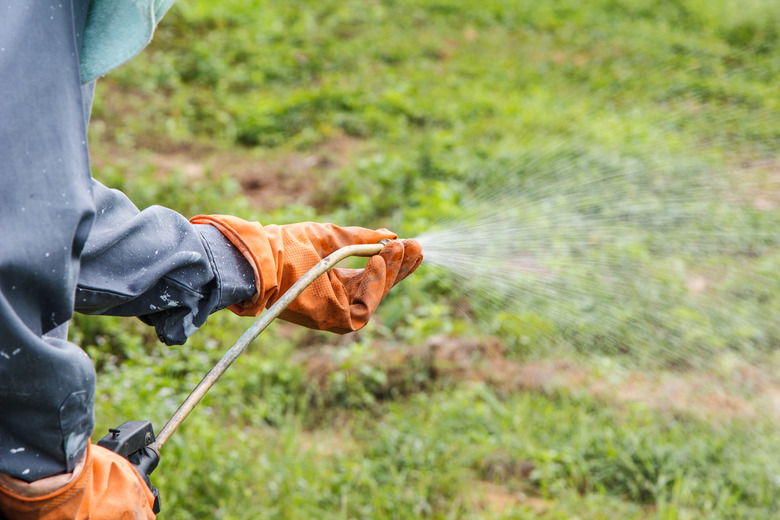What Is The Formula For Mixing Up Vinegar, Salt Water And Dish Soap For Use As A Weed Killer?
We may receive a commission on purchases made from links.
Mixing up household vinegar, salt and dish soap yields a lethal combination for weeds, but it's also harmful to other plants — not just weeds — so plants in the vicinity of weeds being treated may be lost as well. Salt in particular is difficult to manage once it accumulates in soil. It's best to confine the application of this formula to weeds growing in your patios and paths to protect your wanted landscaping plants.
It's worth noting that all vinegars are not the same. Horticultural vinegar, which is an approved herbicide, contains 10 to 20 percent acetic acid. Household vinegar generally only contains 5 percent acetic acid. Vinegar can burn the skin and cause severe injury to the eyes.
Tip
The basic formula is 1 gallon of white vinegar, 1 cup of table salt and 1 tablespoon of liquid dishwashing soap blended and poured into a plastic spray bottle.
DIY Weed Killer Formula
DIY Weed Killer Formula
The formula for this common nontoxic weed killer is 1 gallon of white vinegar, 1 cup of salt (any kind), and 1 tablespoon of a liquid dish detergent that doesn't contain bleach. No water is included. Mix together and pour into a spray bottle.
The solution should be applied topically, and preferably away from desirable plants. Salt especially is detrimental to soil quality and plants; it may reduce water uptake, inhibit seed germination and slow plant growth. Salt accumulation in soil can't be fixed with chemicals, conditioners or fertilizers.
Effects of Vinegar
Effects of Vinegar
Vinegar in the garden is an effective weed killer, proven in research conducted by the U.S. Department of Agriculture. The vinegar was hand-sprayed on the weeds. Common lamb's-quarters, giant foxtail, velvetleaf, smooth pigweed and Canada thistle succumbed to vinegar at 5 and 10 percent acetic acid concentrations, applied in the first two weeks of their appearance. Higher concentrations of vinegar were needed to kill mature weeds; the kill rate was 85 to 100 percent. Perennial weeds were only temporarily deterred; they grew new top growth from the roots.
Stronger Vinegar Sold As Herbicide
Stronger Vinegar Sold As Herbicide
Vinegar is an acid, but it doesn't persist in soil, so it's unlikely to accumulate in amounts that affect the pH balance of soil. USDA only tested vinegar on weeds around corn crops, which weren't harmed. Vinegar can burn plant tissue, so care needs to be taken when applying it on weeds near flowers. Household vinegar is usually 5 percent concentration. Stronger vinegars are sold as herbicides; it's illegal to use vinegar to kill weeds unless it's labeled for that purpose.
How the Formula Works
How the Formula Works
Salt and vinegar are both desiccants; they draw moisture from weeds and other plants. Combining them increases the power. Adding liquid soap detergent increases the absorption of the spray. The soap breaks down the waxy surface of the plant, lowering its defenses against salt and the acetic acid in vinegar. Water sticks to the leaves instead of washing the solution from them. Soap can kill some weeds by itself; oil in soap injures plants.
Applying the DIY Weed Killer
Applying the DIY Weed Killer
Since the vinegar, salt and dish soap weed killer will kill any plants it comes into contact with, choose your location for using it carefully. Use a concentrated spray to control where the vinegar weed killer goes. Apply it on a calm day with no wind to keep the spray from spreading. A sunny day works best as the sun can also help dry up and kill the weeds.
Spray the formula all over the weed to coat all of its surfaces. It can take up to a week to kill the plant. Since the vinegar formula doesn't always kill the roots, you might need to reapply it if the weeds start to grow back. You can also pour more of the weed killer onto the root area of the weeds.
